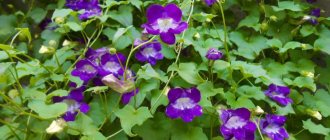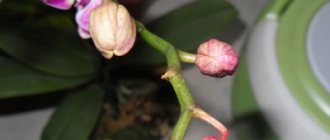Decembrist flower - how to care for it at home?
Flora delights the eye with a variety of plant species of various colors, sizes and bizarre shapes.
One of the most unusual representatives is the South American cactus, which has an interesting name - Decembrist, or zigocactus. This is a very special plant that destroys the idea of what a cactus is, since the specimen described is not very friendly with sunny weather and loves water very much.
It is thanks to its specificity that the Decembrist deserves attention and a place on the windowsill, which is the topic of this article, providing all the necessary information for home breeding of the “foreign guest”.
Why does the Decembrist have limp leaves?
Despite the fact that all plants sold have already been adapted and bred to be as resistant as possible, regardless of the conditions, a frequent problem is a change in the condition of the leaves - they seem to lose moisture, become soft and lethargic, as if they are about to wither completely.
Most often this happens during the heating season, when the radiators dry out the air greatly, and the plants on the windowsill invariably suffer from this. High air humidity is important for the Decembrist, since this cactus comes from tropical forests.
The solution to the problem of leaf lethargy caused by dry air is sought only in methods to increase this indicator. So, the above-ground part can be frequently sprayed with water, or a tray with wet pebbles can be placed next to the pot.
Why do the buds fall off?
Typically, the Christmas tree begins to produce buds in November, and lush flowering begins in December. However, it often happens that, having successfully begun the flowering process, the cactus sheds its buds. This unpleasant event occurs for several reasons.
The first is changing the location of the pot, since zygocactus reacts heavily to a change in its usual place, sometimes even frequent unfolding of the pot ends badly. Low air humidity, excessive watering, low air temperature, temperature changes - all this can lead to the dropping of buds.
It is worth remembering that flowering is the most sensitive and delicate period in the life cycle of a plant, therefore, to maintain it, it is necessary to show maximum attention to the conditions of detention
What to do if Decembrist does not bloom?
The flowering of zygocactus is very beautiful, and almost everyone grows this plant just to enjoy this wonderful event once a year. However, quite often it happens that the flowers simply do not appear, and the expected lush flowering does not occur. If this happens, then it is necessary to reconsider the conditions of detention, because the lack of flowering can be caused by the following factors:
the cactus did not “feel” the onset of this period due to stable environmental conditions
To awaken the plant, from the end of September it needs to be placed in a cooler place and watering reduced, and in November returned to normal conditions with enough light - then the cactus will begin to prepare to release buds; when the plant was supposed to be preparing for flowering, the care conditions were incorrect - insufficient watering, low humidity, little light; flowering can begin only on one side, and this happens due to uneven lighting; the soil should always be well watered, but it is important to avoid stagnation of moisture, otherwise the roots will rot, and then there will be no talk of flowering at all.. In the question of how to make the Decembrist bloom at home, it is important to take into account the specifics of the reason that led to the emergence of such a problem
When the cause is eliminated, the process of bud formation will also improve, and due to the unpretentiousness of the plant, it is usually enough just to strictly follow all care recommendations
In the question of how to make Decembrist bloom at home, it is important to take into account the specifics of the reason that led to the emergence of such a problem. When the cause is eliminated, the process of bud formation will also improve, and due to the unpretentiousness of the plant, it is usually enough just to strictly follow all care recommendations
Photos of varieties of the Decembrist flower
The Decembrist flower is familiar to many and popular, numerous signs are associated with it and it has a decorative function.
When choosing a specimen for your home, it is important to know that there are many varieties of it, which differ, in particular, in the nature of their flowering. Photos depicting different types of plants will help you choose.
March 18, 2022 – life-sup
Watering the Decembrist during flowering and after
At the moment of bud formation, when the spouts are already visible, watering is increased and the regime is maintained throughout the flowering period. For the buds to bloom, high humidity is necessary, such as in the flower’s homeland, where it rains during this period. But even with increased watering, the zygocactus should not float in the water. Water that has not been absorbed after watering for 15-20 minutes must be removed from the pan, as this will provoke rotting of the root mass.
blooming Decembrist in a pot
This is at normal temperature conditions, when the thermometer mark is at +22 degrees Celsius. If during flowering the temperature in the room where the flower grows drops for various reasons, watering is also reduced so that cold temperatures and moisture do not cause the death of the plant. This may contribute to the dropping of flowers, but at critical air temperatures the Decembrist has no time for flowering; the bush itself must be saved. After flowering, watering is reduced, switching to normal mode.
Important! Water the cactus in the morning; evening watering will promote rotting, especially in the cold season.
How to feed the Decembrist at home so that it blooms
Due to the fact that Decembrist belongs to the genus of cactus plants, it needs special feeding that is gentle on the roots. Succulents do not tolerate concentrated fertilizers. If it is not possible to purchase special fertilizer for them, you can use fertilizer for ordinary indoor plants, reducing its concentration by half. The Decembrist responds gratefully to feeding with folk remedies. Such homemade fertilizers cannot cause harm, but they can nourish the plant and improve the composition of the soil.
Folk remedies
Feeding home flowers using folk remedies has become very popular. On forums on the Internet, flower growers discuss the results of using this or that non-standard fertilizer and share with each other the features of its preparation. Fans of the Decembrist recommend using the following types of feeding for him:
Wood ash
Fertilizer can be applied dry or pre-dissolved in water. To prepare the fertilizer, add 2 tablespoons of ash to 1 liter of water and leave for several hours. A nutrient solution can provide the plant with a set of microelements in an easily digestible form. This is an excellent potash fertilizer that can be used during bud formation and flowering.
Hydrogen peroxide
By saturating the earth with oxygen, the product strengthens the root system, promotes the growth of Decembrist and its flowering. To prepare the fertilizer, you need to dilute 1 tbsp. a spoonful of peroxide in a liter of water. Fertilizer is applied during the active growing season once a week by applying it at the root.
Boric acid
The product is prepared in a 0.1 percent concentration and is used to spray leaves. The use of fertilizing stimulates the growth of shoots and promotes the formation of more buds. Recommended for spraying Decembrist leaves during budding and flowering.
Tea infusion
This remedy is often used by experienced gardeners who already know about its effect on increasing the number of buds. In their opinion, no expensive fertilizer will give such a wonderful result. An infusion of tea can cause flowering even in those plants that stubbornly refuse to bloom for several years. To fertilize, brew regular black tea with boiling water, let it brew, and use the tea leaves for watering instead of plain water.
Fresh apple infusion
Schlumbergera is grateful for the use of fertilizing from fresh sour apples. To prepare the fertilizer, cut 2-3 green fruits into small slices and add 500 ml of water. The fertilizing should infuse for 2 days. After this, apple water is used for irrigation. This fertilizer is completely harmless and can be used at any stage of plant development. The frequency of feeding is also not limited in any way.
Complex fertilizer
Special fertilizers for cacti and succulents are good because they contain the entire set of nutrients in the required concentration. When using them, you should not deviate from the manufacturer’s recommendations; prepare the solution strictly according to the instructions. Schlumbergera has sensitive roots and too high doses of minerals can cause harm instead of benefit. Most often, Decembrists are used to feed:
- fertilizer "Ideal";
- liquid complexes for flowering plants;
- all kinds of fertilizers for cacti.
Among other things, the size of the pot is important for good Christmas tree flowering. The container should not be too cramped, otherwise the soil will begin to deplete very quickly. But the Decembrist does not need a large pot, otherwise the flower will begin to grow green mass to the detriment of flowering.
https://youtube.com/watch?v=SdiEoVv_Ho8
What water to use
Tap water is not the best solution for watering Christmas trees, since they are very sensitive to the temperature of the liquid and its composition. In this case, it is advisable to prepare rain, melt or well-filtered water that will not form sediment on the walls or bottom of the pot. In extreme cases, you can use tap water, but only after settling for several days.
For organic nutrition with the addition of fertilizers, settled aquarium water and mineral supplements are ideal. In any case, the liquid temperature should be within +22…+25°C, since at lower values it will not be possible to avoid rotting of the Christmas tree root system.
How to properly water Decembrist seasonally
The main task of Schlumbergera owners is its flowering. This can only be achieved by observing the cyclical development of the plant and following the rules of care for the corresponding stage. The regularity of watering also depends on the stage.
December - January (blooming)
It is important to maintain strength for long flowering, moderate watering in the morning, after 3 - 5 days, supplemented with fertilizer. The substrate must be moist all the time
May - August (active growing season)
It is important to provide conditions for the accumulation of vitality, water moderately, in the evening, after the top layer of soil has dried by 2 - 3 cm, supplement with fertilizing, spraying, and arrange a shower. At this time, the Decembrist is transplanted, propagated
After replanting, resume watering as the substrate dries; the next fertilizing is only after a month.
September - October (budding)
The period of bud setting. Reduce moisture to a minimum (once every 2 weeks). No spraying. Hardening is carried out by lowering the temperature; if the soil becomes very wet, frostbite of the roots may occur.
November
The appearance of buds, resume regular morning moderate watering with warm water, fertilizing, spraying.
By following simple recommendations, growing Schlumbergera will not cause any trouble, and timely lush flowering will bring a lot of positive emotions.
Watering after transplanting
After transplanting Schlumberger, it is better to postpone the first watering for some time. Experienced gardeners advise that if Schlumbergera is not large, water it after 3 days. If the transplanted specimen is older, then water it after a week. This time is necessary so that all wounds on the root system formed after the replanting process can heal.
After transplantation, water may get into the open creases and the roots will begin to rot, which leads to death. There is no need to worry that the Schlumbergera will die without water. After all, when transplanting, the soil is always slightly damp and the forest cactus can cope with the lack of watering.
Important! Delayed watering after replanting is an important rule when replanting a Decembrist into new soil.
Water: how much is required for irrigation?
If we were to write a section for the book “Decembrist Flower: How to Care at Home,” then the chapter on watering could be briefly formulated as follows: watering should not turn into flour either for the plant or for the owner who is dealing with its consequences. Disentangling in the literal sense! The “transfused” Decembrist can:
- discard buds and flowers;
- stop growing;
- rot
Watering is carried out depending on the degree of soil moisture. In winter, this is done no more than once a week, during the rest season - no more than once a month. In summer - keeping the soil moist. Constantly! It is better to water with “soft”, settled water.
Spraying can only be carried out in a room that is only sufficiently warm; during the period of lowering the temperature, which is necessary for the success of flowering, the plant should not be further cooled by spraying water over it.
By reducing watering from August, the plant is gradually brought to the season of color gain; the growth of green mass should completely stop by this time.
Useful care tips
High-quality watering is not the only thing you should pay attention to when caring for the Decembrist. In addition to this, there are several more important growing rules that will help even a novice gardener grow a healthy and strong Christmas tree that regularly delights with its flowering.
First of all, the list of recommendations should include:
- protection from pests, especially if the zygocactus spends some time outdoors (at the first signs of insect activity, the plant should be treated with any local insecticide, repeating the procedure after 6–7 days);
- control of soil moisture and the presence of water in the saucer, which may well cause rotting of the root system;
- combating late blight by re-growing plants from cuttings (if there are several flowers in the room, then an attempt to save one Decembrist may result in the problem spreading to other plants);
- reducing the amount of watering with a simultaneous increase in the frequency of fertilizing during the budding period;
- providing the plant with rest before and during budding (at this time you cannot take Decembrist shoots);
- extension of the flowering period by maintaining reduced temperatures in the room (not higher than +16…+18°C);
- the presence of optimal lighting, without exposing the plant to direct sunlight, which can leave burns on the leaves.
In general, caring for a Christmas tree is no more difficult than caring for other indoor plants, so absolutely everyone can grow Decembrist, and simple recommendations from experienced gardeners will help you avoid minor mistakes.
Feeding
Mineral mixtures twice a month are the easiest option to feed the Decembrist so that it is guaranteed to bloom. Complex fertilizers, which include potassium, phosphorus and nitrogen. Once a year, before flowering, it is recommended to feed the Decembrist plant with organic liquid fertilizer.
There is a small secret that stimulates the zygocactus to bloom and set buds. This is pinching young cuttings, which in the spring begin to grow vigorously at the ends of the leaves. In this case, energy is directed not to the development of leaves, but to flowering and the formation of seeds for the survival of the species.
There are situations when, due to improper heavy feeding, the plant gets burnt to the roots and begins to die. To save it, they pinch off all the new regrown segments and root them, and draw conclusions for themselves based on errors in feeding.
Video: Watering the Decembrist at home
Decembrist photo description
A bushy perennial indoor plant, named by the people “Decembrist”, either in honor of the name of the month, or for the “obstinacy of character”, blooming in December, contrary to the natural laws of the northern hemisphere, the peak of flowering occurs at Christmas, for which it has another name “Christmas cactus". Homeland - coastal tropical Brazil.
In the wild, it lives on trunks, in tangles of tree branches (epiphytes), in crevices of high-mountain rocks (lithophytes), where, despite monsoon rains, water does not linger. Having a meager root system, it feeds on organic products that accumulate in stone cracks and depressions in the bark. Hiding in shady thickets, it is saturated from the moist air with the help of light above-ground roots growing between the segments (cladodes) that make up the stems of the plant, hence the name “forest cactus”.
The succulent ability to accumulate moisture places them in the cactus family, which, oddly enough, does not have a single spine (modified leaves) and the special structure of the annual growths served as another name “zygocactus”. Decembrist does not have leaves; mistaking flat segments for leaves makes a big mistake.
Stems:
- drooping, branched, reaching a length of up to 50 cm;
- consist of numerous flat cladodes (annual growths).
Cladodes:
- have a bright green tint;
- serrated edge with modified areoles (lateral buds) between the serrations;
- growth buds or buds are located at the top of the segment.
Flowers of outlandish beauty that bloom at the beginning of summer, endowed with a white or red color, an elongated tube of pointed multi-tiered petals, with a curved end, long stamens extending far beyond the corolla. Hummingbirds, drinking the moisture collected by the flower with their thin nose, simultaneously pollinate it.
The centuries-old struggle for existence has developed an amazing skill for the survival of the species - reproduction is possible even in one segment. Apparently, thanks to this ability, the Decembrist managed to survive on the other side of the equator.
For more than two centuries, zygocactus has been delighting with its bright colors in winter, preserving all the properties of natural growth, presenting a variety of possibilities to breeders. The name used in scientific circles - Schlumbergera - the plant received in honor of the French botanist collector Frederic Schlumberger (1823 - 1893), who first proved that it belongs to the cactus family.
The modern variety of Schlumberger includes more than a hundred varieties, differing in:
- size, shape and color of cladodes;
- shades, size of flowers;
- quantity, terryness of petals.
There are varieties with erect stems, ampelous; low-growing and shoots reaching up to 1 meter. Despite so many different varieties, simplicity and stability of care remains, including watering.
Top dressing
If all of the above rules are taken into account, and the Decembrist does not bloom, then it is most likely a lack of nutrients, so it needs to be fed. Feeding begins in the spring and ends in early autumn. In summer, the amount of nutrients applied is doubled. The best folk recipes are:
- Sugar - This is the easiest and most affordable way to feed. Thanks to the energy that glucose provides, the plant can spend it on flowering. Dissolve two tablespoons of sugar in a liter jar of water and water the soil. In parallel with it, it is necessary to add any EM drug that will replenish the amount of carbon dioxide. Otherwise, mold may grow in the ground. Sweet water should be watered no more than once a month.
- Ash - It is added to the ground when replanting a house plant. If replanting is not planned, then dissolve two tablespoons of ordinary wood ash in a liter jar of water, leave for about three hours, and then water it. You can simply sprinkle the ground with ash and pour water on top. The useful minerals contained in the ash will help the Decembrist recover. It is especially useful if the flower lacks potassium. This can be seen by the yellowed leaves.
- Boric acid - If you spray with a solution of boric acid, the number of inflorescences will increase. To do this, 0.1% boric acid is dissolved in a liter of liquid. Spraying is carried out in December and during flowering. It is undesirable to perform this procedure in direct sunlight, otherwise the leaves may get burned.
- Diluted mullein - They are fed with it six months after transplantation, but you need to remember that it accelerates the onset of budding, so it is not added in the fall so that the flower has time to rest. To feed, one-fifth of the mullein is dissolved in a liter jar of liquid. It can be replaced with bird droppings.
- Hydrogen peroxide - Thanks to it, the root system of the flower will be able to receive enough oxygen and be healthy. To do this, dissolve half a tablespoon of hydrogen peroxide in two glasses of water. Water once a week. It is not advisable to spray greens with this solution.
- Citrus fruits - Take the peel of any citrus fruit, chop it finely, then pour boiling water over it. Leave for about a day, filter and water once a week, diluting in advance with the same amount of water.
- Apples – This requires only tart green apples. They need to be cut into small pieces, filled with water and left to infuse for about two days. Then water twice a week. This tincture can be used to water a houseplant at any time, even during the dormant period. It only brings benefits.
- Tea - This is the most unusual and effective way to achieve the beginning of budding in a plant. To do this, brew a glass of black tea leaves in a three-liter jar of boiling water. Then they wait until it cools down, after which they water it twice a week. No expensive product can compare with tea leaves.
- Yeast - They can replace almost all chemical fertilizers due to the large number of useful substances contained in them. Dissolve two tablespoons of dry yeast in one liter of warm water and add a tablespoon of sugar. Leave for about two hours. Then dilute with five liters of water and water the Decembrist.
Frequent mistakes when watering Decembrist
Sometimes inexperienced flower growers, purchasing a flower because of its beautiful appearance, are in no hurry to familiarize themselves with certain rules for caring for it. Therefore, certain problems arise:
- Too frequent and abundant watering.
- Rare watering, considering that cacti do not need to be watered.
- Water immediately after transplanting.
- Applying fertilizers to dry soil.
- Rare watering during flowering.
- Watering during the autumn dormant period.
excessive watering of the Decembrist led to decay
All these errors lead to a lack of flowering or to the death of the entire bush.
Reproduction methods
There are several ways to propagate the Christmas tree:
- cuttings;
- vaccination.
The most accessible and effective method is cuttings. Breeding a Christmas tree using a scion is a much more difficult task, but can also be done at home.
How to propagate Decembrist by cuttings
1. Time for reproduction. Zygocactus cuttings take root well, regardless of the time of year and the weather outside the window. But the best time to start breeding Decembrist is from April to May. At this time, the mother plant has already flowered.
2. Selecting a cutting. For leaf propagation, healthy, undamaged cuttings from three separate elements are suitable. It is necessary to inspect the plant and select a separate shoot with small roots. If you want to grow a lush bush, you will need several cuttings.
It is preferable to select shoots from a less dense area of the plant, this is explained by the fact that after cuttings the adult plant is rejuvenated, and in place of the cut shoots others will begin to grow intensively and bloom profusely.
3. Separation of the cuttings from the mother plant. Under no circumstances cut off the shoot with a knife, scalpel, scissors or other sharp objects. Use only your hands. Take the stalk, pinch it a little and twist it, turning it around its axis. Hold the plant with your other hand so as not to accidentally break it.
4. Preparing the cutting for planting. The shoots need to be dried; to do this, they are left in a container in a dry and dark room for a day. A transparent film forms at the site of separation - this means that the plant is ready for planting. If possible, the cuttings can be sprinkled with sand or charcoal.
5. Soil preparation. The easiest way is to buy universal soil for cacti in a specialized store. Soil acidity should be between 5.5-6.5 pH.
You can also prepare the substrate yourself. Optimal soil composition for Decembrist:
- leaf soil - 6 parts;
- humus soil - 4 parts;
- peat – 2 parts;
- sand – 2 parts;
- turf soil - 1 part.
Zygocactus grows better in soil that is enriched with peat, so some gardeners grow Christmas trees in pure peat. The two main conditions that apply to the substrate are lightness and breathability.
Note: a third of the pot is filled with drainage to avoid stagnation of water in the pot.
6. Planting cuttings. The size of the flowerpot should not greatly exceed the volume of the root system. The roots of zygocactus are poorly developed, so there is no need for a large pot. The pot is filled one-third with drainage, and one-half with prepared substrate. The soil is slightly pressed down and moistened. A depression is made in the center and a shoot is planted. If you need to plant several cuttings, make holes according to the number of plants.
If it so happens that it’s time to plant the shoots, but you haven’t had time to purchase a flowerpot yet, use disposable cups. The top of the plant should be covered with a glass container or polyethylene.
7. Growing conditions. The container is immediately placed in partial shade and the temperature is maintained from +15 to +20 degrees. Plants need to be ventilated regularly - the cover is removed daily for 20-30 minutes. Moderate watering is required.
For complete rooting, the Christmas tree needs 3 to 4 weeks. As soon as new leaf segments appear on the cuttings, it is transplanted into a permanent flowerpot.
Reproduction by grafting
This technique is unpopular and is used extremely rarely. If you want to experiment and learn new floriculture techniques, try planting Decembrist. Two plants are suitable for this:
- prickly pear;
- Pereskia spinosa.
The upper part of the prickly pear or pereschia is cut off, the stem is cleared of leaves and split closer to the upper edge. 2-3 segments of Decembrist are used as a scion; the lower part must be sharpened and inserted into the prepared slot. After this, the grafting site is fixed with a needle and adhesive tape. Plants grow together at a temperature of +18 degrees for several weeks.
The fixing bandage can be removed as soon as the plant begins to grow. All side shoots and leaves on the plant to which the Decembrist was grafted must be removed, otherwise the rootstock will not have enough strength to provide the grafted cuttings with nutrients. If the grafting process is done correctly, the Decembrist will bloom in the first winter.











